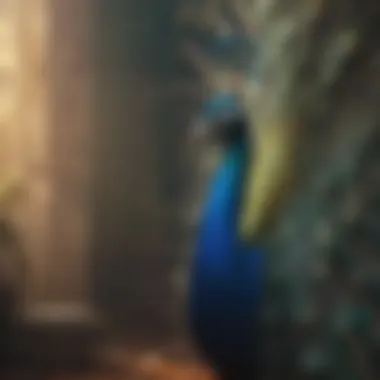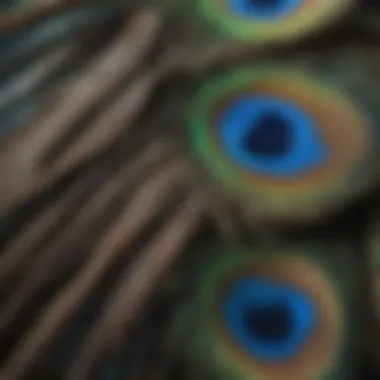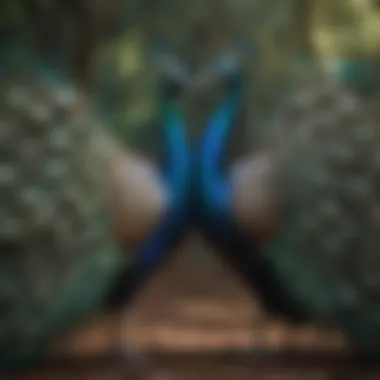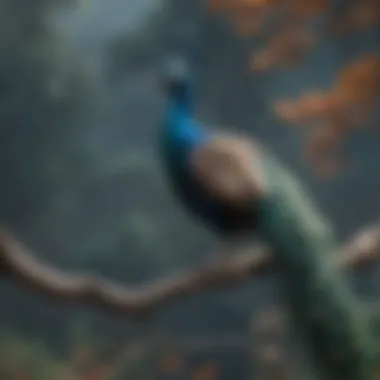Unveiling the Enchanting World of Peacocks: A Journey Into Beauty and Mystery


Animal Species Profile
Peacocks, or peafowl, belong to the pheasant family and are renowned for their spellbinding beauty and distinctive characteristics. Their most prominent feature is the stunning plumage of the male peacocks, characterized by iridescent hues and intricate patterns that mesmerize onlookers. It is important to note, however, that not all peacocks display these ornate plumages; in fact, it is the male peafowl or peacocks that exhibit such flamboyant feathers to attract mates and ward off potential threats. These majestic birds are predominantly found in South Asia, but they have also been introduced to various other parts of the world due to their aesthetic appeal.
In terms of their physical appearance, peacocks are sizable birds, with males being larger than females. The vibrant colors of their plumage extend beyond their well-known tail feathers, comprising various shades of blue, green, and gold. In contrast, female peafowl, known as peahens, exhibit more subdued colors, allowing them to blend seamlessly into their surroundings to safeguard their nests and offspring from predators. Their glorious plumage not only serves a decorative purpose but also plays a vital role in their intricate courtship displays.
Peafowl are typically found in diverse habitats ranging from forests and grasslands to cultivated areas and human settlements across South Asia. They have been introduced to regions outside their natural range, such as North America and Australia, due to their captivating beauty and cultural significance. These birds are known for their adaptability to various environments, showcasing their resilience and ability to thrive in different settings.
When observing peafowl in their natural habitat, one cannot help but be captivated by their complex behaviors and social interactions. Male peacocks engage in elaborate courtship dances, featuring vibrant displays of their iridescent plumage paired with vocalizations to attract peahens. In contrast, peahens exhibit a more subtle approach, carefully assessing potential mates based on their displays and behaviors. Additionally, peafowl showcase hierarchical social structures, with dominant individuals asserting their authority through vocalizations and physical displays, while maintaining peace within the flock through established pecking orders.
Introduction
The enigmatic world of peacocks stands out as a subject of tremendous allure and fascination, beckoning enthusiasts and scholars alike to delve into the depths of their captivating existence. This section serves as a gateway to the extraordinary realm of these avian wonders, laying the foundation for profound insights into their evolutionary journey, intricate physical features, and diverse habitats. By setting the stage with this detailed exploration, readers can grasp the significance of peacocks in the natural world and appreciate the complexity of factors that contribute to their mesmerizing presence.
Overview of Peacocks
Evolutionary History
Peering into the evolutionary timeline of peacocks unveils a tapestry of adaptations and survival strategies that have shaped their distinctive characteristics over millennia. The intricate dance of selection pressures and environmental dynamics has honed the peacock's evolutionary trajectory, resulting in a creature adorned with unparalleled beauty and grandeur. Understanding the evolutionary narrative provides a holistic view of why peacocks exhibit particular behaviors and physiological traits, inviting us to appreciate the marvels of natural selection at play within this avian marvel.
Physical Features
The ostentatious plumage of peacocks epitomizes extravagance in the animal kingdom, serving as a beacon of allure and desirability. Their physical features, from the iridescent plumage to the imposing tail feathers, reflect not just aesthetic appeal but also functional significance in the peacock's ecosystem. Delving into the specifics of their physical attributes unveils a world of intricate biological mechanisms and adaptive advantages that underline the evolutionary success of these majestic birds.
Habitats
Exploring the habitats of peacocks unveils a tapestry of ecological landscapes where these birds establish their presence and thrive. From lush tropical forests to semi-arid savannas, peacocks exhibit remarkable adaptability to a range of environments, each influencing their behavior and survival strategies. Understanding the nuances of their habitats provides crucial insights into the dynamics of coexistence with other species and the intricate balance required for peacocks to flourish in the wild.
Peacock's Plumage
Peacock's plumage is a topic of immense importance in this article as it serves as a distinctive feature that sets peacocks apart from other avian species. The ornate plumage of peacocks plays a crucial role in their courtship rituals and overall survival in the wild. The vibrant colors and intricate patterns of their feathers not only attract potential mates but also act as a form of camouflage in their natural habitats. Understanding the evolution and significance of peacock's plumage provides valuable insights into the behavior and ecology of these magnificent birds, making it a focal point of this exploration.
Coloration
Structural Composition
The structural composition of peacock feathers is a marvel of natural engineering, consisting of intricately arranged barbules that reflect light to produce their iridescent hues. Each individual feather is composed of thousands of these barbules, meticulously interlocked to create a shimmering effect. This structural arrangement not only enhances the visual appeal of peacocks but also serves functional purposes such as insulation and aerodynamics. The lightweight yet durable nature of this composition makes it an adaptive advantage for peacocks, enabling them to display their beauty while maintaining agility and protection in various environments.


Significance
The significance of peacock's coloration lies in its dual role of attracting mates and deterring predators. The vivid blues, greens, and bronzes of their feathers signal genetic fitness and health to potential partners during courtship displays. Simultaneously, these bold colors serve as a warning signal to predators, indicating the presence of toxins ingested through their diet. This dual-purpose coloration strategy showcases the evolutionary adaptation and survival tactics employed by peacocks in their natural habitats. The unique feature of their coloration not only enhances their visual allure but also communicates vital information essential for their reproductive success and survival in the wild.
Molting Patterns
Seasonal Changes
Seasonal changes play a crucial role in the molting patterns of peacocks, influencing the renewal and regrowth of their plumage. During specific times of the year, peacocks shed old feathers to make way for new ones, adapting to environmental conditions and reproductive cycles. Seasonal changes trigger hormonal shifts that regulate the molting process, ensuring that peacocks maintain optimal feather quality and appearance throughout the year. Understanding the seasonal dynamics of molting sheds light on how peacocks adjust their plumage to survive changing climates and mating seasons.
Regrowth Cycles
Regrowth cycles are integral to the continuous replenishment of peacock feathers, ensuring that males maintain their elaborate displays for courtship and social signaling. After molting, regrowth cycles dictate the speed and quality of feather regeneration, influenced by factors such as diet, age, and hormonal fluctuations. The regrowth process involves the gradual development of colorful plumage, starting from specialized cells in the skin called follicles. These regrowth cycles are finely tuned to optimize the vibrancy and sustainability of peacock plumage, highlighting the intricate biological mechanisms behind their visual splendor.
Behavioral Traits of Peacocks
Peacocks exhibit a diverse range of behavioral traits that play a crucial role in understanding their fascinating nature. These behaviors encompass various aspects of their lives, from courtship rituals to social interactions. One cannot overlook the significance of behavioral traits when exploring the world of peacocks, as they offer insights into the complex dynamics and hierarchy within peacock communities. Understanding the behavioral traits of peacocks provides a window into their communication methods, mating behaviors, and daily routines, shedding light on their intricate social structures and survival strategies. By delving into the behavioral characteristics of peacocks, we unravel the mystery behind their captivating behavior and gain a deeper appreciation for these majestic birds.
Courtship Displays
Peacocks are renowned for their extravagant courtship displays, whereby they showcase their vibrant plumage and intricate behaviors to attract potential mates. Within courtship displays, two distinct aspects, namely dance rituals and feather displays, take center stage in the peacock's mating repertoire.
Dance Rituals
Dance rituals form a fundamental part of a peacock's courtship display, characterized by intricate movements and rhythmic gestures. The dance rituals serve as a means for male peacocks to demonstrate their vitality, strength, and genetic fitness to female peahens. Through these carefully choreographed performances, peacocks convey their suitability as mates, thereby increasing their chances of successful reproduction.
Furthermore, the unique feature of dance rituals lies in their ability to showcase the physical prowess and coordination of the peacock, allowing onlookers to admire the grace and agility of these birds. However, the disadvantage of dance rituals may lie in the energy expenditure required to perform such elaborate displays, which could potentially impact the peacock's overall fitness and survival in the wild.
Feather Displays
Feather displays represent another captivating aspect of peacock courtship displays, where the male peacock unfurls its iridescent feathers in a visually stunning spectacle. The vibrant colors and intricate patterns of the peacock's plumage serve as a visual cue to attract potential mates and signify genetic quality and overall well-being.
The unique feature of feather displays lies in their visual appeal and ability to captivate the attention of female peahens, allowing the male peacock to stand out amidst competitors. However, the disadvantage of feather displays may stem from the risk of predation or heightened visibility to potential threats while drawing attention to oneself.
Social Interactions
Social interactions among peacocks play a vital role in establishing and maintaining hierarchical structures within peacock communities. These interactions are governed by two main aspects: hierarchy dynamics and communication methods.
Hierarchy Dynamics


Hierarchy dynamics dictate the social order among peacocks, determining dominance, access to resources, and mating opportunities within the group. Peacocks establish a clear hierarchy through displays of aggression, submission, and territorial behaviors, ensuring a structured social environment that promotes stability and order.
The key characteristic of hierarchy dynamics lies in their role in minimizing conflicts and maximizing cooperation within peacock communities, ultimately enhancing overall group cohesion and functionality. However, the disadvantage of hierarchy dynamics may arise from the potential for stress and competition among individuals vying for status and resources.
Communication Methods
Communication methods form the foundation of social interactions among peacocks, allowing for the exchange of information, establishment of territories, and coordination of group activities. Peacocks employ a diverse array of vocalizations, body language, and visual cues to convey messages and maintain social bonds within the community.
The key characteristic of communication methods lies in their efficacy in facilitating cooperation, mate selection, and mutual recognition among peacocks. By utilizing various communication channels, peacocks can navigate social complexities and ensure efficient coordination within the group. However, the disadvantage of communication methods may lie in the misinterpretation of signals or potential conflicts arising from misunderstandings in communication.
Peacock's Diet and Feeding Habits
Natural Diet
Peacocks have a diverse natural diet that plays a crucial role in their sustenance. Their foraging behavior, characterized by meticulous search and selection of food, is a key aspect of their diet. Peacocks exhibit unique foraging behavior that involves scavenging for insects, seeds, and small reptiles in their surroundings. This behavior ensures that they acquire essential nutrients for growth and development, making it a popular choice for discussion in this article.
Foraging Behavior
The foraging behavior of peacocks is distinguished by their methodical approach to seeking food sources. Their keen sense of sight and agility enable them to locate insects hidden in foliage with precision. This behavior is advantageous as it allows peacocks to procure a diverse range of nutrients necessary for their dietary requirements. However, the downside of this behavior is the potential exposure to predators while scouring for food in open areas.
Food Preferences
Peacocks exhibit distinct food preferences that influence their dietary intake. These preferences are driven by factors such as taste, nutritional value, and availability of food sources in their environment. Understanding these preferences provides valuable insights into the dietary choices of peacocks and how it impacts their overall health. Their inclination towards specific food types underscores the importance of discussing food preferences in this detailed examination.
Feeding Patterns
Analyzing the feeding patterns of peacocks offers valuable insights into their daily routines and nutritional requirements. Peacocks follow specific feeding patterns to meet their energy needs and maintain their physical well-being. By observing their feeding habits, we gain a deeper understanding of how peacocks regulate their nutritional intake and adapt to environmental changes.
Daily Routines
The daily routines of peacocks revolve around structured feeding sessions that coincide with their natural behavioral patterns. These routines dictate when and where peacocks feed, ensuring they meet their dietary needs consistently. The disciplined approach to daily feeding highlights the importance of maintaining a balanced diet for peacocks to thrive in their ecosystems.
Nutritional Needs
Peacocks have specific nutritional needs that must be met to support their growth and vitality. Understanding these needs is essential for ensuring the well-being of peacocks in captivity and the wild. By addressing the unique nutritional requirements of peacocks, we illuminate the role of diet in sustaining their health and promoting their immune system. Examining their nutritional needs provides a holistic view of the factors influencing their dietary choices and feeding behaviors.
Conservation Status of Peacocks
Being at the upper echelon of the avian hierarchy, the conservation status of peacocks warrants meticulous attention. As formidable creatures overshadowed by a delicate beauty, peacocks face a myriad of threats that imperil their existence. Understanding the conservation status of peacocks not only sheds light on the challenges they confront but also emphasizes the necessity of protective measures for their survival.


Threats and Challenges
Habitat Loss
Habitat loss stands as a colossal menace to the continuum of peacock populations worldwide. The encroachment of human infrastructure, deforestation, and urbanization largely characterizes this insidious phenomenon. Its detrimental impact on peacocks' natural habitats disrupts breeding grounds, foraging areas, and territorial integrity, consequently leading to dwindling population numbers. This pivotal aspect of habitat loss embodies an alarming truth – the infringement of ecosystems vital for peacock sustenance. Despite its ubiquitous nature, habitat loss remains a vital focal point in this discourse due to its significant role in the declining peacock populace. The nuanced features of habitat loss illuminate a struggle for survival that unfolds amidst a backdrop of human intervention and environmental degradation.
Illegal Trade
Within the domain of peacock welfare, the illicit trade targeting these resplendent birds poses a critical challenge. Illegal trade thrives on the allure of the peacock's plumage, coveted for its aesthetic appeal and commercial value. The clandestine nature of this trade exacerbates the vulnerability of peacocks, subjecting them to exploitation for financial gain. This noxious practice not only impacts individual birds but also jeopardizes the genetic diversity and overall sustainability of peacock populations. The illicit trade of peacocks epitomizes a heinous exploitation that undermines conservation efforts, necessitating stringent regulatory measures to combat this nefarious activity.
Conservation Efforts
Protective Measures
To alleviate the pressures posed by habitat loss and illegal trade, protective measures emerge as a beacon of hope for peacock conservation. Implementing safeguards such as habitat restoration, protected areas designation, and anti-poaching laws are instrumental in safeguarding peacock habitats and curbing illicit trade activities. Protective measures embody a proactive stance towards preserving peacock populations, emphasizing the communal responsibility in securing these magnificent birds' future.
Research Initiatives
Research initiatives play a pivotal role in augmenting conservation strategies and enhancing our understanding of peacock dynamics. By delving into peacock behaviors, habitat requirements, and population trends, research initiatives provide valuable insights for formulating targeted conservation plans. The emphasis on data-driven approaches underscores the importance of evidence-based practices in mitigating threats to peacock populations. Through collaborative research ventures and scientific inquiry, conservationists and wildlife enthusiasts can champion the cause of peacock preservation, ensuring a harmonious coexistence between humans and these enchanting avian species.
Cultural Significance of Peacocks
Peacocks hold a significant cultural presence across various societies, symbolizing different aspects depending on the culture. The symbolism associated with peacocks transcends boundaries and resonates deeply with people worldwide. From religious symbolism to artistic interpretations, peacocks have influenced language, art, and customs throughout history. Understanding the cultural significance of peacocks provides insights into how these magnificent birds have shaped human beliefs and traditions.
Symbolism in Various Cultures
Religious Symbolism
In the realm of religious symbolism, peacocks are often revered for their association with immortality and renewal. The stunning plumage of the peacock is linked to concepts of resurrection and spiritual rejuvenation in several belief systems. The vibrant colors of the peacock feathers symbolize divine beauty and the eternal cycle of life. This aspect of religious symbolism highlights the birds' connection to themes of transcendence and divine grace. The inclusion of peacocks in religious iconography serves as a visual representation of purity and enlightenment.
Artistic Depictions
Artistic depictions of peacocks have been prevalent in various art forms, showcasing the birds' beauty and regality. Peacocks have inspired artists with their intricate patterns and vibrant colors, leading to stunning visual representations in paintings, sculptures, and textiles. The graceful posture of peacocks and their majestic crowns of feathers have become emblematic of artistic elegance and sophistication. The use of peacocks in art symbolizes opulence, beauty, and the free spirit of nature. Artistic depictions of peacocks enrich cultural narratives and add a touch of splendor to creative expressions.
Peacocks in Mythology
Peacocks have etched their presence in mythology, becoming symbols of mythologyrgical significance across different cultures. Legends and folklore surrounding peacocks often portray them as beings of wisdom and protection. Their inclusion in mythical narratives signifies themes of royalty, guidance, and symbolism. In some mythologies, peacocks are associated with guardianship and foresight, serving as omens of prosperity and good fortune. The mythical representations of peacocks evoke a sense of wonder and enchantment, intertwining the natural world with celestial mysteries.
Legends and Folklore
Within the realm of legends and folklore, peacocks are often depicted as magical creatures that bring harmony and prosperity. Their presence in myths symbolizes the connection between humanity and the divine forces of nature. Legends surrounding peacocks speak of their ability to safeguard sacred spaces and ward off evil spirits. These mythical narratives highlight the revered status of peacocks as bearers of fortune and blessings.
Mythical Representations
Mythical representations of peacocks vary across cultures, portraying the birds in different roles within the mythological landscape. Peacocks symbolize qualities such as nobility, protection, and vision in various mythologies, reflecting the diverse interpretations of their natural attributes. The mythical allure of peacocks adds a layer of mystique to ancient tales and legends, emphasizing the birds' symbolic importance in shaping cultural beliefs and traditions.







